Analysis of Drug Therapy for Sharon Case Study in NUR231
VerifiedAdded on 2023/02/01
|7
|2333
|48
Homework Assignment
AI Summary
This assignment analyzes a case study of a 58-year-old woman, Sharon, who has type 2 diabetes and chronic kidney disease. The assignment addresses Sharon's current medication (Metformin), her blood glucose levels, and the potential addition of Glucovance to her prescription. It explores the risks associated with Glucovance, specifically the concern of lactic acidosis due to the patient's kidney disease. The assignment proposes two new medications: one to lower blood sugar without exercise and another to neutralize lactic acid. The assignment also discusses the Registered Nurse Standards of Practice, emphasizing the importance of evidence-based practice in providing safe and quality care for Sharon, considering her medical history and current condition. The analysis includes relevant references to support the arguments and recommendations regarding Sharon's drug therapy management.

UNIT:
NAME:
DATE:
NAME:
DATE:
Paraphrase This Document
Need a fresh take? Get an instant paraphrase of this document with our AI Paraphraser
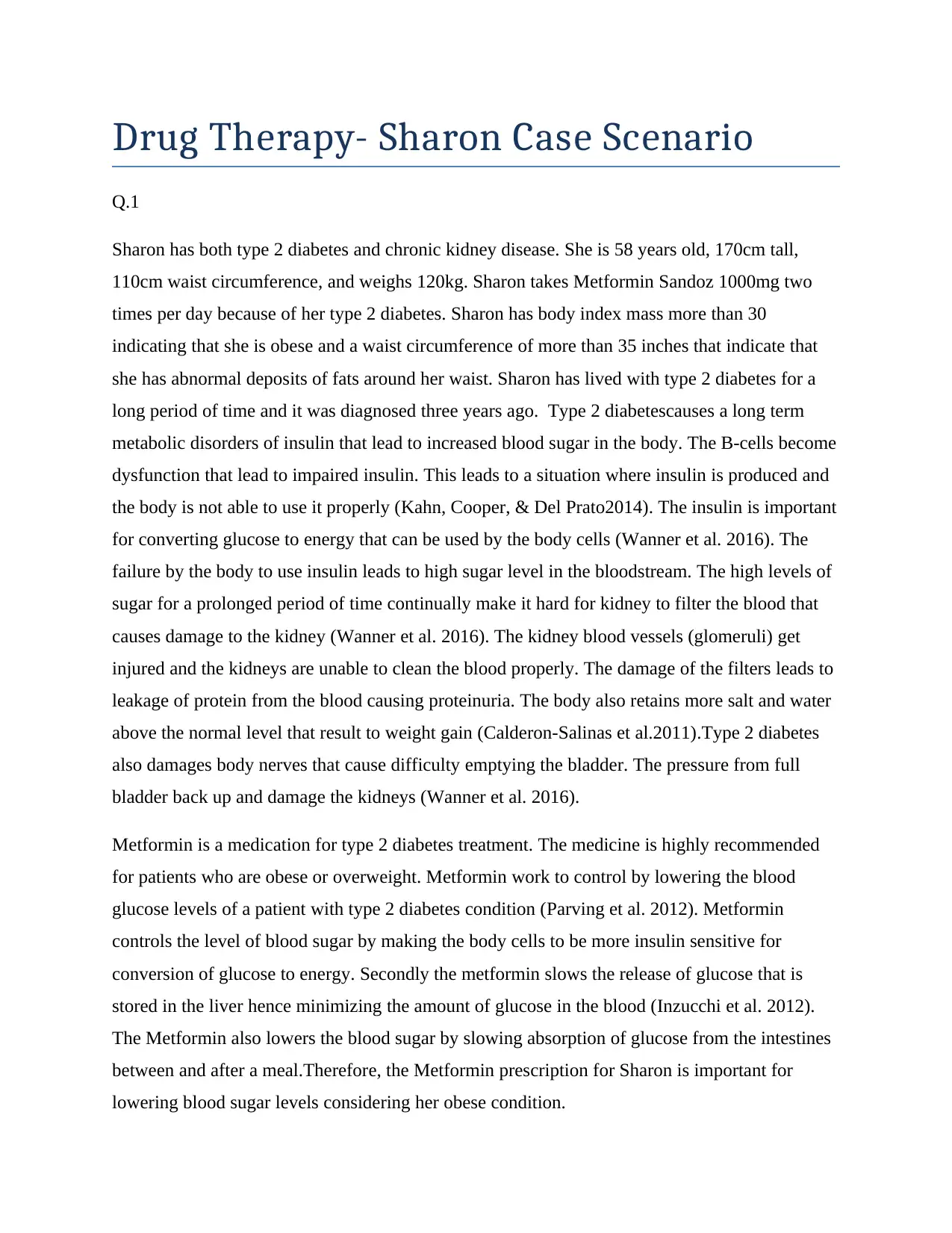
Drug Therapy- Sharon Case Scenario
Q.1
Sharon has both type 2 diabetes and chronic kidney disease. She is 58 years old, 170cm tall,
110cm waist circumference, and weighs 120kg. Sharon takes Metformin Sandoz 1000mg two
times per day because of her type 2 diabetes. Sharon has body index mass more than 30
indicating that she is obese and a waist circumference of more than 35 inches that indicate that
she has abnormal deposits of fats around her waist. Sharon has lived with type 2 diabetes for a
long period of time and it was diagnosed three years ago. Type 2 diabetescauses a long term
metabolic disorders of insulin that lead to increased blood sugar in the body. The B-cells become
dysfunction that lead to impaired insulin. This leads to a situation where insulin is produced and
the body is not able to use it properly (Kahn, Cooper, & Del Prato2014). The insulin is important
for converting glucose to energy that can be used by the body cells (Wanner et al. 2016). The
failure by the body to use insulin leads to high sugar level in the bloodstream. The high levels of
sugar for a prolonged period of time continually make it hard for kidney to filter the blood that
causes damage to the kidney (Wanner et al. 2016). The kidney blood vessels (glomeruli) get
injured and the kidneys are unable to clean the blood properly. The damage of the filters leads to
leakage of protein from the blood causing proteinuria. The body also retains more salt and water
above the normal level that result to weight gain (Calderon-Salinas et al.2011).Type 2 diabetes
also damages body nerves that cause difficulty emptying the bladder. The pressure from full
bladder back up and damage the kidneys (Wanner et al. 2016).
Metformin is a medication for type 2 diabetes treatment. The medicine is highly recommended
for patients who are obese or overweight. Metformin work to control by lowering the blood
glucose levels of a patient with type 2 diabetes condition (Parving et al. 2012). Metformin
controls the level of blood sugar by making the body cells to be more insulin sensitive for
conversion of glucose to energy. Secondly the metformin slows the release of glucose that is
stored in the liver hence minimizing the amount of glucose in the blood (Inzucchi et al. 2012).
The Metformin also lowers the blood sugar by slowing absorption of glucose from the intestines
between and after a meal.Therefore, the Metformin prescription for Sharon is important for
lowering blood sugar levels considering her obese condition.
Q.1
Sharon has both type 2 diabetes and chronic kidney disease. She is 58 years old, 170cm tall,
110cm waist circumference, and weighs 120kg. Sharon takes Metformin Sandoz 1000mg two
times per day because of her type 2 diabetes. Sharon has body index mass more than 30
indicating that she is obese and a waist circumference of more than 35 inches that indicate that
she has abnormal deposits of fats around her waist. Sharon has lived with type 2 diabetes for a
long period of time and it was diagnosed three years ago. Type 2 diabetescauses a long term
metabolic disorders of insulin that lead to increased blood sugar in the body. The B-cells become
dysfunction that lead to impaired insulin. This leads to a situation where insulin is produced and
the body is not able to use it properly (Kahn, Cooper, & Del Prato2014). The insulin is important
for converting glucose to energy that can be used by the body cells (Wanner et al. 2016). The
failure by the body to use insulin leads to high sugar level in the bloodstream. The high levels of
sugar for a prolonged period of time continually make it hard for kidney to filter the blood that
causes damage to the kidney (Wanner et al. 2016). The kidney blood vessels (glomeruli) get
injured and the kidneys are unable to clean the blood properly. The damage of the filters leads to
leakage of protein from the blood causing proteinuria. The body also retains more salt and water
above the normal level that result to weight gain (Calderon-Salinas et al.2011).Type 2 diabetes
also damages body nerves that cause difficulty emptying the bladder. The pressure from full
bladder back up and damage the kidneys (Wanner et al. 2016).
Metformin is a medication for type 2 diabetes treatment. The medicine is highly recommended
for patients who are obese or overweight. Metformin work to control by lowering the blood
glucose levels of a patient with type 2 diabetes condition (Parving et al. 2012). Metformin
controls the level of blood sugar by making the body cells to be more insulin sensitive for
conversion of glucose to energy. Secondly the metformin slows the release of glucose that is
stored in the liver hence minimizing the amount of glucose in the blood (Inzucchi et al. 2012).
The Metformin also lowers the blood sugar by slowing absorption of glucose from the intestines
between and after a meal.Therefore, the Metformin prescription for Sharon is important for
lowering blood sugar levels considering her obese condition.
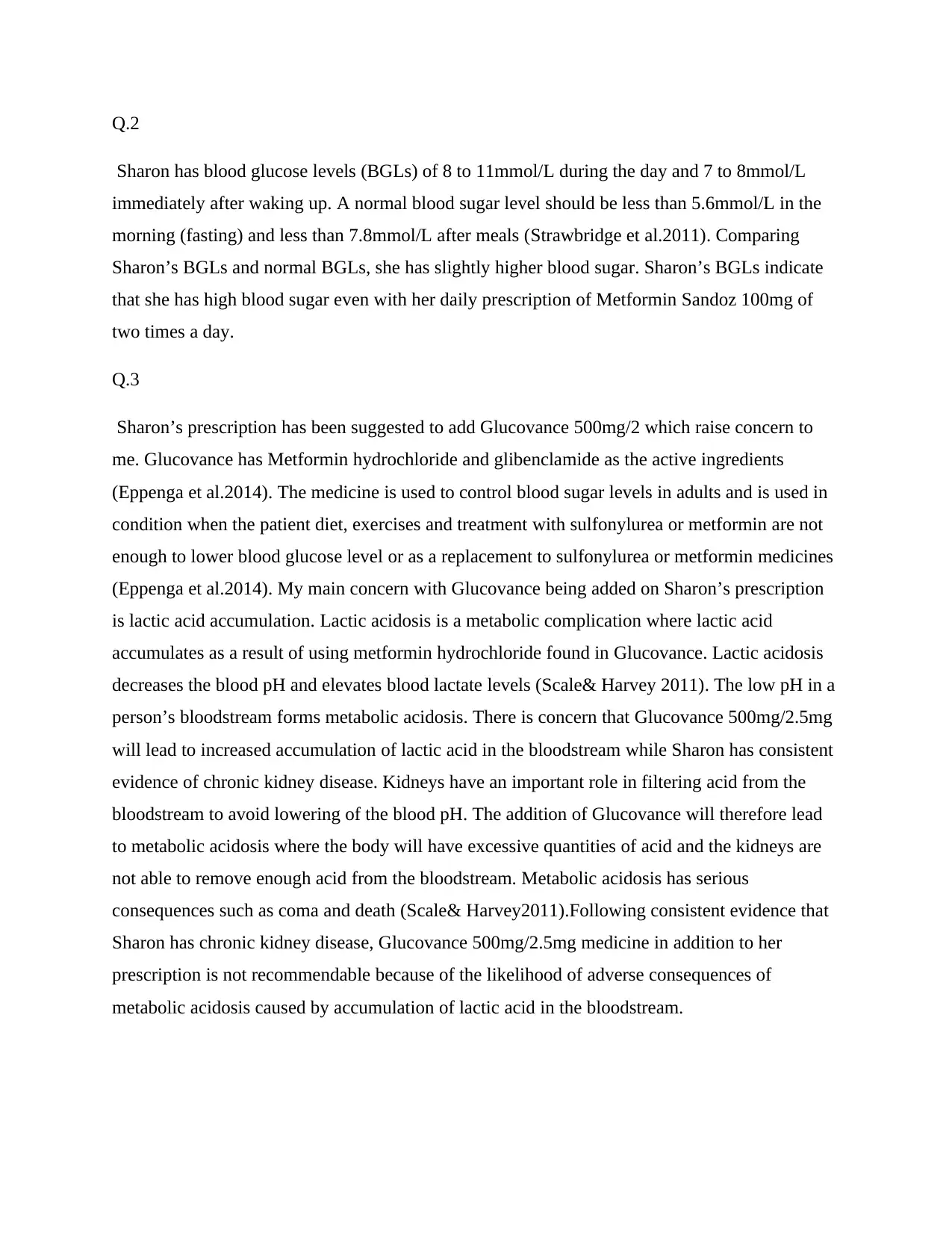
Q.2
Sharon has blood glucose levels (BGLs) of 8 to 11mmol/L during the day and 7 to 8mmol/L
immediately after waking up. A normal blood sugar level should be less than 5.6mmol/L in the
morning (fasting) and less than 7.8mmol/L after meals (Strawbridge et al.2011). Comparing
Sharon’s BGLs and normal BGLs, she has slightly higher blood sugar. Sharon’s BGLs indicate
that she has high blood sugar even with her daily prescription of Metformin Sandoz 100mg of
two times a day.
Q.3
Sharon’s prescription has been suggested to add Glucovance 500mg/2 which raise concern to
me. Glucovance has Metformin hydrochloride and glibenclamide as the active ingredients
(Eppenga et al.2014). The medicine is used to control blood sugar levels in adults and is used in
condition when the patient diet, exercises and treatment with sulfonylurea or metformin are not
enough to lower blood glucose level or as a replacement to sulfonylurea or metformin medicines
(Eppenga et al.2014). My main concern with Glucovance being added on Sharon’s prescription
is lactic acid accumulation. Lactic acidosis is a metabolic complication where lactic acid
accumulates as a result of using metformin hydrochloride found in Glucovance. Lactic acidosis
decreases the blood pH and elevates blood lactate levels (Scale& Harvey 2011). The low pH in a
person’s bloodstream forms metabolic acidosis. There is concern that Glucovance 500mg/2.5mg
will lead to increased accumulation of lactic acid in the bloodstream while Sharon has consistent
evidence of chronic kidney disease. Kidneys have an important role in filtering acid from the
bloodstream to avoid lowering of the blood pH. The addition of Glucovance will therefore lead
to metabolic acidosis where the body will have excessive quantities of acid and the kidneys are
not able to remove enough acid from the bloodstream. Metabolic acidosis has serious
consequences such as coma and death (Scale& Harvey2011).Following consistent evidence that
Sharon has chronic kidney disease, Glucovance 500mg/2.5mg medicine in addition to her
prescription is not recommendable because of the likelihood of adverse consequences of
metabolic acidosis caused by accumulation of lactic acid in the bloodstream.
Sharon has blood glucose levels (BGLs) of 8 to 11mmol/L during the day and 7 to 8mmol/L
immediately after waking up. A normal blood sugar level should be less than 5.6mmol/L in the
morning (fasting) and less than 7.8mmol/L after meals (Strawbridge et al.2011). Comparing
Sharon’s BGLs and normal BGLs, she has slightly higher blood sugar. Sharon’s BGLs indicate
that she has high blood sugar even with her daily prescription of Metformin Sandoz 100mg of
two times a day.
Q.3
Sharon’s prescription has been suggested to add Glucovance 500mg/2 which raise concern to
me. Glucovance has Metformin hydrochloride and glibenclamide as the active ingredients
(Eppenga et al.2014). The medicine is used to control blood sugar levels in adults and is used in
condition when the patient diet, exercises and treatment with sulfonylurea or metformin are not
enough to lower blood glucose level or as a replacement to sulfonylurea or metformin medicines
(Eppenga et al.2014). My main concern with Glucovance being added on Sharon’s prescription
is lactic acid accumulation. Lactic acidosis is a metabolic complication where lactic acid
accumulates as a result of using metformin hydrochloride found in Glucovance. Lactic acidosis
decreases the blood pH and elevates blood lactate levels (Scale& Harvey 2011). The low pH in a
person’s bloodstream forms metabolic acidosis. There is concern that Glucovance 500mg/2.5mg
will lead to increased accumulation of lactic acid in the bloodstream while Sharon has consistent
evidence of chronic kidney disease. Kidneys have an important role in filtering acid from the
bloodstream to avoid lowering of the blood pH. The addition of Glucovance will therefore lead
to metabolic acidosis where the body will have excessive quantities of acid and the kidneys are
not able to remove enough acid from the bloodstream. Metabolic acidosis has serious
consequences such as coma and death (Scale& Harvey2011).Following consistent evidence that
Sharon has chronic kidney disease, Glucovance 500mg/2.5mg medicine in addition to her
prescription is not recommendable because of the likelihood of adverse consequences of
metabolic acidosis caused by accumulation of lactic acid in the bloodstream.
⊘ This is a preview!⊘
Do you want full access?
Subscribe today to unlock all pages.

Trusted by 1+ million students worldwide

Q.4
The medications available are not suitable for Sharon’s current condition. Sharon has both
diabetes and chronic kidney disease whose treatment lead to more complication. In order to
improve Sharon’s quality of life and increase her life expectancy, there is need to invent two new
medicines that adequately treat her condition. The medicines will have to lower blood sugar to
normal BGLs while not leaving lactic acid accumulations in the bloodstream that require
effective and efficient functionality of kidneys.
The first medicine to be invented to treat Sharon’s condition is medicine for lowering blood
sugar level even without combination of exercises and diet. Sharon is obese and advancing in age
and she is incapable of exercising regularly. This aspect makes the current medicine, metformin
ineffective for lowering Sharon’s BGLs to normal blood sugar level. The medicine will make the
body active similar to what exercises does that will allow the body muscles to require and use
more sugar for energy (Way et al. 2016). The body will also be stimulated to increase insulin
sensitivity and cells will be able to use available insulin and absorb glucose from the
bloodstream to provide energy to the body. The medicine will simply burn calories and make the
patient’s body react as if there has been a certain level of physical exercises. This medicine will
therefore be used together with metformin to improve the effectiveness of the latter to lower the
blood sugar in the bloodstream.
The second medicine that can be potentially invented to prevent adverse Sharon’s condition is a
lactic acid neutralizing medicines. The medicine will contain base elements that will neutralize
acid in the blood. The medicine will be used together with Glucovance and continually neutralize
the lactic acid accumulations caused by metforminhydrochloride. The lactic acid accumulation in
Sharon’s bloodstream cannot be filtered because she has chronic kidney disease. The
accumulation of lactic acid cause metabolic acidosis as a result of lowering blood pH whose
consequences can be fatal (Lepelley et al. 2016). The medicine will neutralize the lactic acid left
in the bloodstream after using the Glucovance. This will raise the blood pH and prevent
metabolic acidosis caused by accumulating lactic acid in the blood. The medicine will therefore
ensure the blood pH is not affected by usage of Glucovance 500mg/2mg and the latter can be
used even when the patient has chronic kidney disease. Sharon will therefore be able to take
The medications available are not suitable for Sharon’s current condition. Sharon has both
diabetes and chronic kidney disease whose treatment lead to more complication. In order to
improve Sharon’s quality of life and increase her life expectancy, there is need to invent two new
medicines that adequately treat her condition. The medicines will have to lower blood sugar to
normal BGLs while not leaving lactic acid accumulations in the bloodstream that require
effective and efficient functionality of kidneys.
The first medicine to be invented to treat Sharon’s condition is medicine for lowering blood
sugar level even without combination of exercises and diet. Sharon is obese and advancing in age
and she is incapable of exercising regularly. This aspect makes the current medicine, metformin
ineffective for lowering Sharon’s BGLs to normal blood sugar level. The medicine will make the
body active similar to what exercises does that will allow the body muscles to require and use
more sugar for energy (Way et al. 2016). The body will also be stimulated to increase insulin
sensitivity and cells will be able to use available insulin and absorb glucose from the
bloodstream to provide energy to the body. The medicine will simply burn calories and make the
patient’s body react as if there has been a certain level of physical exercises. This medicine will
therefore be used together with metformin to improve the effectiveness of the latter to lower the
blood sugar in the bloodstream.
The second medicine that can be potentially invented to prevent adverse Sharon’s condition is a
lactic acid neutralizing medicines. The medicine will contain base elements that will neutralize
acid in the blood. The medicine will be used together with Glucovance and continually neutralize
the lactic acid accumulations caused by metforminhydrochloride. The lactic acid accumulation in
Sharon’s bloodstream cannot be filtered because she has chronic kidney disease. The
accumulation of lactic acid cause metabolic acidosis as a result of lowering blood pH whose
consequences can be fatal (Lepelley et al. 2016). The medicine will neutralize the lactic acid left
in the bloodstream after using the Glucovance. This will raise the blood pH and prevent
metabolic acidosis caused by accumulating lactic acid in the blood. The medicine will therefore
ensure the blood pH is not affected by usage of Glucovance 500mg/2mg and the latter can be
used even when the patient has chronic kidney disease. Sharon will therefore be able to take
Paraphrase This Document
Need a fresh take? Get an instant paraphrase of this document with our AI Paraphraser
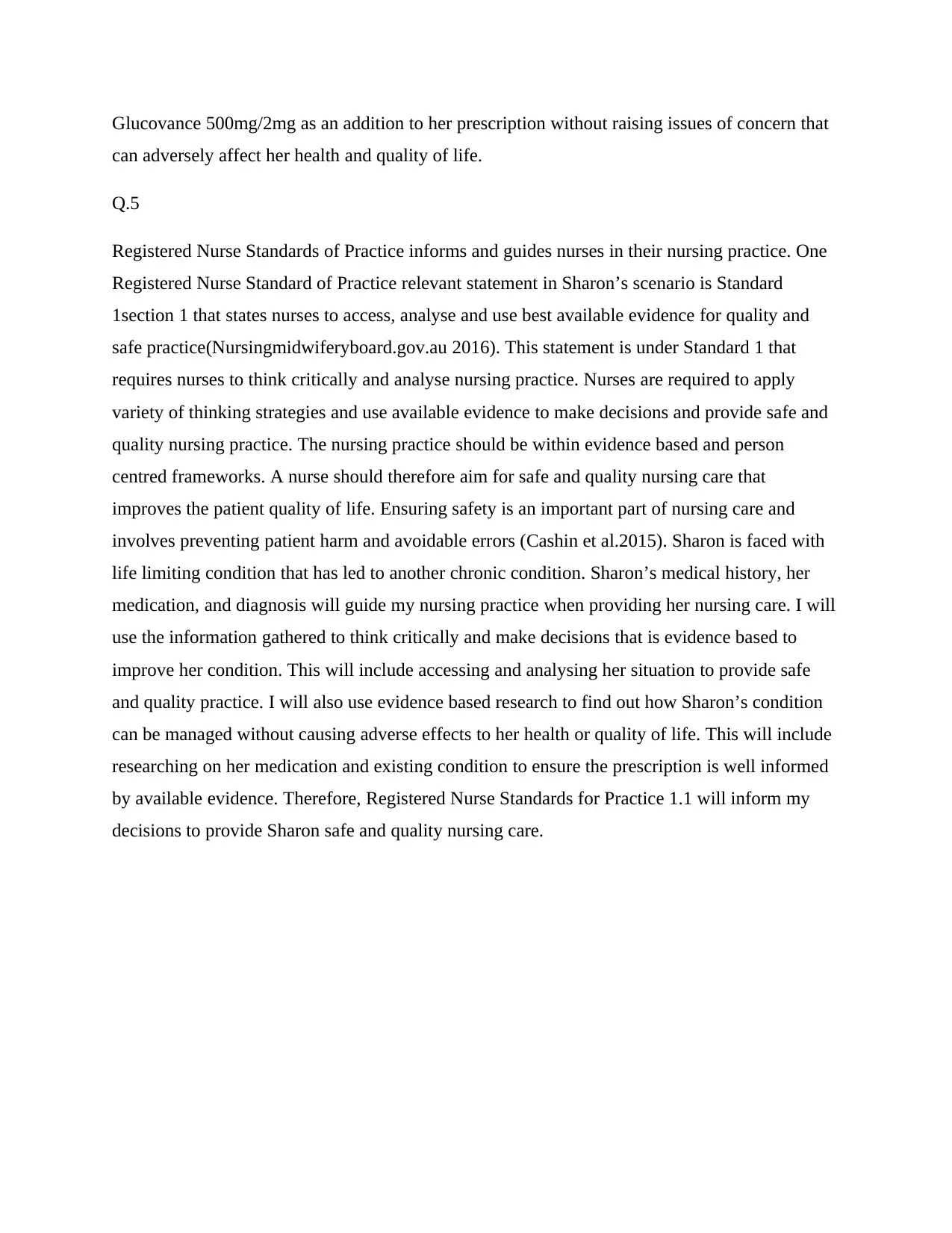
Glucovance 500mg/2mg as an addition to her prescription without raising issues of concern that
can adversely affect her health and quality of life.
Q.5
Registered Nurse Standards of Practice informs and guides nurses in their nursing practice. One
Registered Nurse Standard of Practice relevant statement in Sharon’s scenario is Standard
1section 1 that states nurses to access, analyse and use best available evidence for quality and
safe practice(Nursingmidwiferyboard.gov.au 2016). This statement is under Standard 1 that
requires nurses to think critically and analyse nursing practice. Nurses are required to apply
variety of thinking strategies and use available evidence to make decisions and provide safe and
quality nursing practice. The nursing practice should be within evidence based and person
centred frameworks. A nurse should therefore aim for safe and quality nursing care that
improves the patient quality of life. Ensuring safety is an important part of nursing care and
involves preventing patient harm and avoidable errors (Cashin et al.2015). Sharon is faced with
life limiting condition that has led to another chronic condition. Sharon’s medical history, her
medication, and diagnosis will guide my nursing practice when providing her nursing care. I will
use the information gathered to think critically and make decisions that is evidence based to
improve her condition. This will include accessing and analysing her situation to provide safe
and quality practice. I will also use evidence based research to find out how Sharon’s condition
can be managed without causing adverse effects to her health or quality of life. This will include
researching on her medication and existing condition to ensure the prescription is well informed
by available evidence. Therefore, Registered Nurse Standards for Practice 1.1 will inform my
decisions to provide Sharon safe and quality nursing care.
can adversely affect her health and quality of life.
Q.5
Registered Nurse Standards of Practice informs and guides nurses in their nursing practice. One
Registered Nurse Standard of Practice relevant statement in Sharon’s scenario is Standard
1section 1 that states nurses to access, analyse and use best available evidence for quality and
safe practice(Nursingmidwiferyboard.gov.au 2016). This statement is under Standard 1 that
requires nurses to think critically and analyse nursing practice. Nurses are required to apply
variety of thinking strategies and use available evidence to make decisions and provide safe and
quality nursing practice. The nursing practice should be within evidence based and person
centred frameworks. A nurse should therefore aim for safe and quality nursing care that
improves the patient quality of life. Ensuring safety is an important part of nursing care and
involves preventing patient harm and avoidable errors (Cashin et al.2015). Sharon is faced with
life limiting condition that has led to another chronic condition. Sharon’s medical history, her
medication, and diagnosis will guide my nursing practice when providing her nursing care. I will
use the information gathered to think critically and make decisions that is evidence based to
improve her condition. This will include accessing and analysing her situation to provide safe
and quality practice. I will also use evidence based research to find out how Sharon’s condition
can be managed without causing adverse effects to her health or quality of life. This will include
researching on her medication and existing condition to ensure the prescription is well informed
by available evidence. Therefore, Registered Nurse Standards for Practice 1.1 will inform my
decisions to provide Sharon safe and quality nursing care.
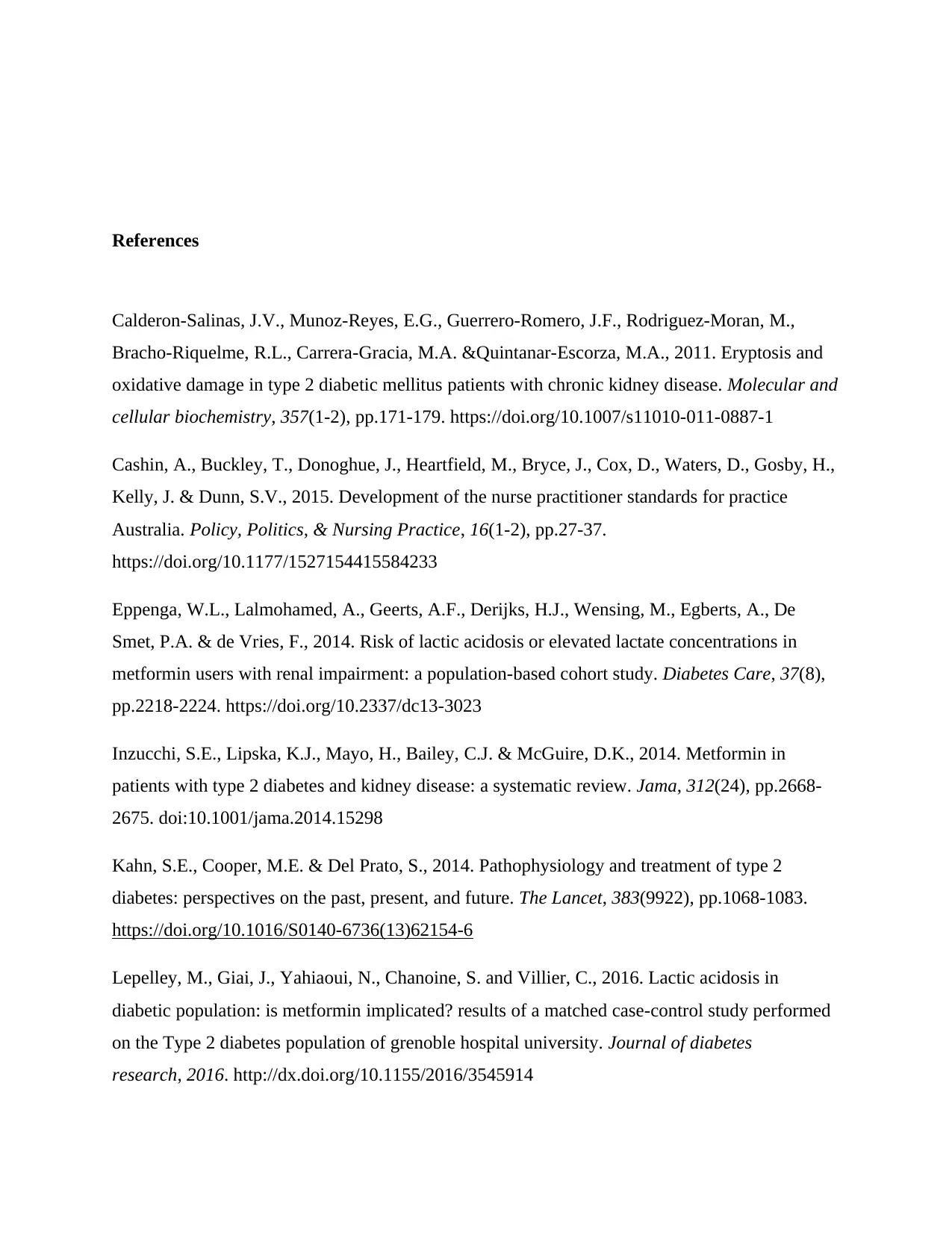
References
Calderon-Salinas, J.V., Munoz-Reyes, E.G., Guerrero-Romero, J.F., Rodriguez-Moran, M.,
Bracho-Riquelme, R.L., Carrera-Gracia, M.A. &Quintanar-Escorza, M.A., 2011. Eryptosis and
oxidative damage in type 2 diabetic mellitus patients with chronic kidney disease. Molecular and
cellular biochemistry, 357(1-2), pp.171-179. https://doi.org/10.1007/s11010-011-0887-1
Cashin, A., Buckley, T., Donoghue, J., Heartfield, M., Bryce, J., Cox, D., Waters, D., Gosby, H.,
Kelly, J. & Dunn, S.V., 2015. Development of the nurse practitioner standards for practice
Australia. Policy, Politics, & Nursing Practice, 16(1-2), pp.27-37.
https://doi.org/10.1177/1527154415584233
Eppenga, W.L., Lalmohamed, A., Geerts, A.F., Derijks, H.J., Wensing, M., Egberts, A., De
Smet, P.A. & de Vries, F., 2014. Risk of lactic acidosis or elevated lactate concentrations in
metformin users with renal impairment: a population-based cohort study. Diabetes Care, 37(8),
pp.2218-2224. https://doi.org/10.2337/dc13-3023
Inzucchi, S.E., Lipska, K.J., Mayo, H., Bailey, C.J. & McGuire, D.K., 2014. Metformin in
patients with type 2 diabetes and kidney disease: a systematic review. Jama, 312(24), pp.2668-
2675. doi:10.1001/jama.2014.15298
Kahn, S.E., Cooper, M.E. & Del Prato, S., 2014. Pathophysiology and treatment of type 2
diabetes: perspectives on the past, present, and future. The Lancet, 383(9922), pp.1068-1083.
https://doi.org/10.1016/S0140-6736(13)62154-6
Lepelley, M., Giai, J., Yahiaoui, N., Chanoine, S. and Villier, C., 2016. Lactic acidosis in
diabetic population: is metformin implicated? results of a matched case-control study performed
on the Type 2 diabetes population of grenoble hospital university. Journal of diabetes
research, 2016. http://dx.doi.org/10.1155/2016/3545914
Calderon-Salinas, J.V., Munoz-Reyes, E.G., Guerrero-Romero, J.F., Rodriguez-Moran, M.,
Bracho-Riquelme, R.L., Carrera-Gracia, M.A. &Quintanar-Escorza, M.A., 2011. Eryptosis and
oxidative damage in type 2 diabetic mellitus patients with chronic kidney disease. Molecular and
cellular biochemistry, 357(1-2), pp.171-179. https://doi.org/10.1007/s11010-011-0887-1
Cashin, A., Buckley, T., Donoghue, J., Heartfield, M., Bryce, J., Cox, D., Waters, D., Gosby, H.,
Kelly, J. & Dunn, S.V., 2015. Development of the nurse practitioner standards for practice
Australia. Policy, Politics, & Nursing Practice, 16(1-2), pp.27-37.
https://doi.org/10.1177/1527154415584233
Eppenga, W.L., Lalmohamed, A., Geerts, A.F., Derijks, H.J., Wensing, M., Egberts, A., De
Smet, P.A. & de Vries, F., 2014. Risk of lactic acidosis or elevated lactate concentrations in
metformin users with renal impairment: a population-based cohort study. Diabetes Care, 37(8),
pp.2218-2224. https://doi.org/10.2337/dc13-3023
Inzucchi, S.E., Lipska, K.J., Mayo, H., Bailey, C.J. & McGuire, D.K., 2014. Metformin in
patients with type 2 diabetes and kidney disease: a systematic review. Jama, 312(24), pp.2668-
2675. doi:10.1001/jama.2014.15298
Kahn, S.E., Cooper, M.E. & Del Prato, S., 2014. Pathophysiology and treatment of type 2
diabetes: perspectives on the past, present, and future. The Lancet, 383(9922), pp.1068-1083.
https://doi.org/10.1016/S0140-6736(13)62154-6
Lepelley, M., Giai, J., Yahiaoui, N., Chanoine, S. and Villier, C., 2016. Lactic acidosis in
diabetic population: is metformin implicated? results of a matched case-control study performed
on the Type 2 diabetes population of grenoble hospital university. Journal of diabetes
research, 2016. http://dx.doi.org/10.1155/2016/3545914
⊘ This is a preview!⊘
Do you want full access?
Subscribe today to unlock all pages.

Trusted by 1+ million students worldwide
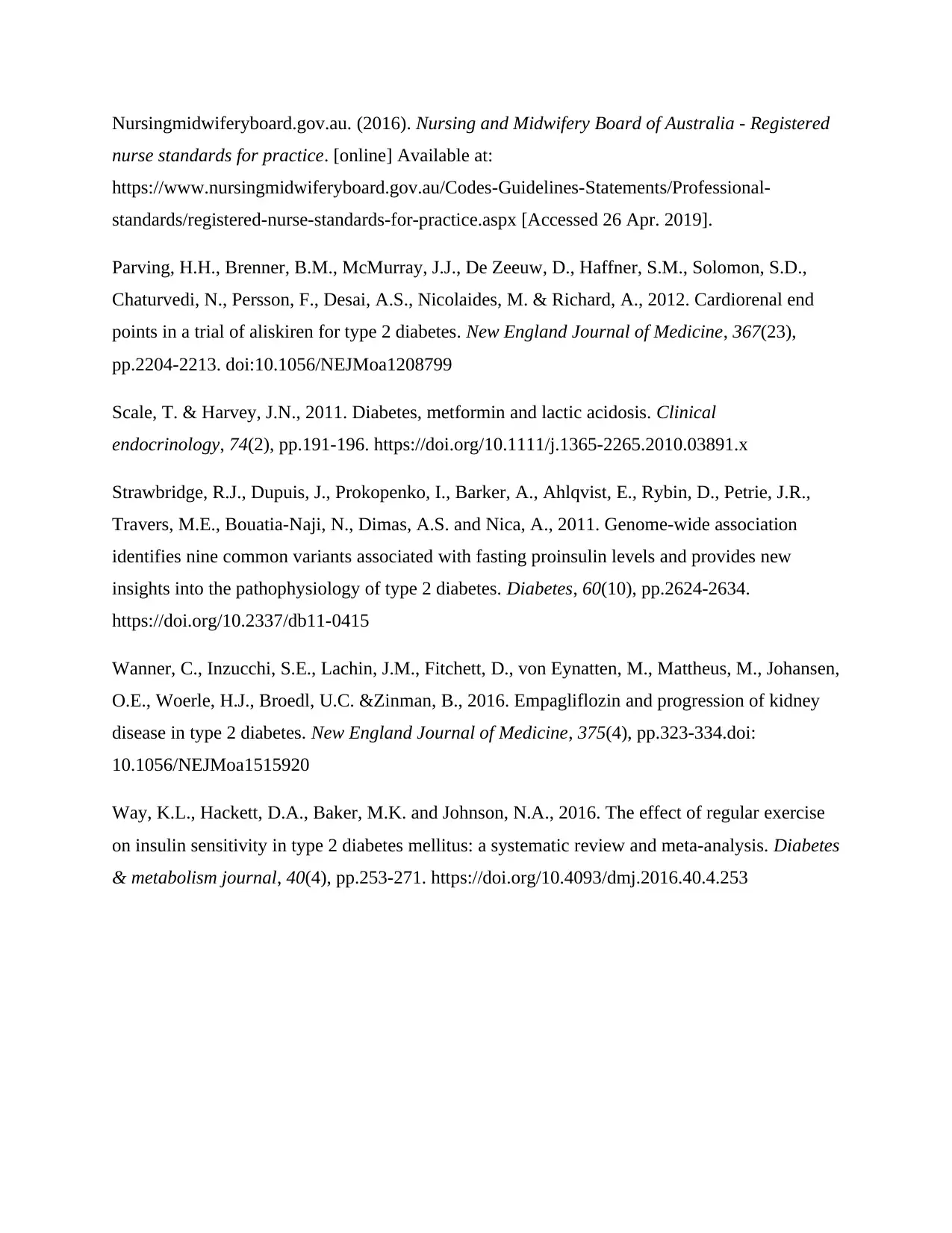
Nursingmidwiferyboard.gov.au. (2016). Nursing and Midwifery Board of Australia - Registered
nurse standards for practice. [online] Available at:
https://www.nursingmidwiferyboard.gov.au/Codes-Guidelines-Statements/Professional-
standards/registered-nurse-standards-for-practice.aspx [Accessed 26 Apr. 2019].
Parving, H.H., Brenner, B.M., McMurray, J.J., De Zeeuw, D., Haffner, S.M., Solomon, S.D.,
Chaturvedi, N., Persson, F., Desai, A.S., Nicolaides, M. & Richard, A., 2012. Cardiorenal end
points in a trial of aliskiren for type 2 diabetes. New England Journal of Medicine, 367(23),
pp.2204-2213. doi:10.1056/NEJMoa1208799
Scale, T. & Harvey, J.N., 2011. Diabetes, metformin and lactic acidosis. Clinical
endocrinology, 74(2), pp.191-196. https://doi.org/10.1111/j.1365-2265.2010.03891.x
Strawbridge, R.J., Dupuis, J., Prokopenko, I., Barker, A., Ahlqvist, E., Rybin, D., Petrie, J.R.,
Travers, M.E., Bouatia-Naji, N., Dimas, A.S. and Nica, A., 2011. Genome-wide association
identifies nine common variants associated with fasting proinsulin levels and provides new
insights into the pathophysiology of type 2 diabetes. Diabetes, 60(10), pp.2624-2634.
https://doi.org/10.2337/db11-0415
Wanner, C., Inzucchi, S.E., Lachin, J.M., Fitchett, D., von Eynatten, M., Mattheus, M., Johansen,
O.E., Woerle, H.J., Broedl, U.C. &Zinman, B., 2016. Empagliflozin and progression of kidney
disease in type 2 diabetes. New England Journal of Medicine, 375(4), pp.323-334.doi:
10.1056/NEJMoa1515920
Way, K.L., Hackett, D.A., Baker, M.K. and Johnson, N.A., 2016. The effect of regular exercise
on insulin sensitivity in type 2 diabetes mellitus: a systematic review and meta-analysis. Diabetes
& metabolism journal, 40(4), pp.253-271. https://doi.org/10.4093/dmj.2016.40.4.253
nurse standards for practice. [online] Available at:
https://www.nursingmidwiferyboard.gov.au/Codes-Guidelines-Statements/Professional-
standards/registered-nurse-standards-for-practice.aspx [Accessed 26 Apr. 2019].
Parving, H.H., Brenner, B.M., McMurray, J.J., De Zeeuw, D., Haffner, S.M., Solomon, S.D.,
Chaturvedi, N., Persson, F., Desai, A.S., Nicolaides, M. & Richard, A., 2012. Cardiorenal end
points in a trial of aliskiren for type 2 diabetes. New England Journal of Medicine, 367(23),
pp.2204-2213. doi:10.1056/NEJMoa1208799
Scale, T. & Harvey, J.N., 2011. Diabetes, metformin and lactic acidosis. Clinical
endocrinology, 74(2), pp.191-196. https://doi.org/10.1111/j.1365-2265.2010.03891.x
Strawbridge, R.J., Dupuis, J., Prokopenko, I., Barker, A., Ahlqvist, E., Rybin, D., Petrie, J.R.,
Travers, M.E., Bouatia-Naji, N., Dimas, A.S. and Nica, A., 2011. Genome-wide association
identifies nine common variants associated with fasting proinsulin levels and provides new
insights into the pathophysiology of type 2 diabetes. Diabetes, 60(10), pp.2624-2634.
https://doi.org/10.2337/db11-0415
Wanner, C., Inzucchi, S.E., Lachin, J.M., Fitchett, D., von Eynatten, M., Mattheus, M., Johansen,
O.E., Woerle, H.J., Broedl, U.C. &Zinman, B., 2016. Empagliflozin and progression of kidney
disease in type 2 diabetes. New England Journal of Medicine, 375(4), pp.323-334.doi:
10.1056/NEJMoa1515920
Way, K.L., Hackett, D.A., Baker, M.K. and Johnson, N.A., 2016. The effect of regular exercise
on insulin sensitivity in type 2 diabetes mellitus: a systematic review and meta-analysis. Diabetes
& metabolism journal, 40(4), pp.253-271. https://doi.org/10.4093/dmj.2016.40.4.253
1 out of 7
Related Documents
Your All-in-One AI-Powered Toolkit for Academic Success.
+13062052269
info@desklib.com
Available 24*7 on WhatsApp / Email
![[object Object]](/_next/static/media/star-bottom.7253800d.svg)
Unlock your academic potential
Copyright © 2020–2025 A2Z Services. All Rights Reserved. Developed and managed by ZUCOL.





